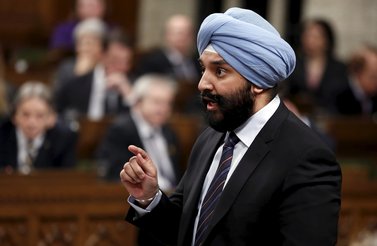Navdeep Bains, Canada’s minister of innovation, science and industry, didn’t wait for my first question when we connected for a phone interview on December 17. He was still excited about the new Gateway Treaty with the United States that will see a Canadian astronaut orbit the moon in 2023.
“Yesterday’s space announcement was very special,” he said.
Noted.
Often, Bains’s portfolio gets lost in the shuffle of Canadian economic policy coverage. The Bank of Canada and the finance minister have been deploying unprecedented amounts of stimulus cash in fighting the COVID-19 crisis, which has left little ink or airtime for anyone else, even a minister who has hundreds of millions of dollars at his disposal.
The industry minister probably deserves more attention than he receives. COVID-19 has accelerated the shift to a digital economy, making issues such as industrial development, competition rules, privacy and cybersecurity even more important than they were before the pandemic.
Bains is Canada’s chief policy maker on all of those files. Here’s an edited version of our conversation on how he plans to confront the post-pandemic economy.
Why is it so important that Canada is sending astronauts to the moon — well, not to the moon, exactly, but to that part of the universe?
This is the first time that we’re sending astronauts to deep space, the second behind the United States to do so. It’s a remarkable feat for a spacefaring nation.
The science and the research are very compelling when you’re up there, in the Lunar Gateway lab, the science lab; you can look at cardiovascular issues and bone-density issues and other science and health-science-related issues. The commercial aspects of bringing the robotics technology to our industrial policy is very compelling. If you look at what we’ve done with Canadarm1 and Canadarm2, and now what we do in Canadarm3 around robotics and AI [artificial intelligence], some of those same technologies are being deployed across the country.
But I would say the most compelling reason — as I see it, as the father of two young girls — is how it inspires young people to pursue a career in science, technology, engineering and mathematics. Their eyes light up. When Jeremy Hansen and I announced it together — he’s one of our four astronauts — you could see the grade-five students, the hope it provided. The energy. It’s been a very, very tough year, particularly on young people.
I imagine that some of my harder-hearted readers will find that a rather expensive way to inspire students.
It’s not only us. It’s the Europeans. The Japanese. Americans. This [Lunar Gateway] is about international collaboration. It’s the relationships we build. This is not Canada going it alone. This is a multilateral effort.
I think, going forward as a very mature and sophisticated country, this is about making sure that we continue to play a leadership role in an area where we’ve seen enormous benefits. We will have, as part of the US-Canada treaty, end-to-end control over the robotics, and so the application for AI use of robotics, and how we can integrate that.
The commercial applications are also overwhelmingly important for us to be able to compete.
Your Industry Strategy Council has called for an “industrial strategy.” Are you going to do one?
We already have one.
You may recall in 2015 we had high unemployment. We had modest growth and we had no innovation policy, not only in terms of our traditional tech companies, but also to help with the transition in the automotive sector, the aerospace sector, the shipbuilding sector, the agriculture sector, the forestry sector, the energy sector — just to name a few.
We put forward our Innovation and Skills Plan. It’s important to know that not only did we see growth, not only did we see jobs created and a lower unemployment rate, but we turned the corner on some of the key areas around talent. Our Global Skills Strategy enabled us to attract top-tier global talent. So, for every visa that we issued under the Global Skills Strategy, we created 10 Canadian jobs.
We saw companies scaling up. In 2015, there were only seven companies that were positioned to be what we call unicorns. Last year, that number was 42. So we were able to significantly increase the number of companies that were scaling and growing in Canada, due to a range of programs around talent that I highlighted, and programming like the Strategic Innovation Fund or the supercluster initiatives. But also because of the capital that was unlocked due to investments that we made at that Venture Capital Catalyst Initiative through Business Development Canada, and we saw a record VC financing of $6.2 billion. The point I’m making is that we were turning the corner. We were able to do that because we had a strong industrial policy and innovation and skills plan.
"We were turning a corner and the pandemic hit. The fact that we have a strong foundation enabled us to really mobilize Canadian entrepreneurs, researchers, innovators and scientists for a made-in-Canada initiative..."
And I want to thank the Industry Strategy Council, because they believe in a partnership model. Globally speaking, other countries don’t have a laissez-faire approach. Governments have very clear strategies on sectors, on technologies, and so that’s part of their industrial policy. In Canada, if we want to compete globally, if we want our companies to compete globally, if we want to create jobs and growth, we have to be strategic and smart. So, I think the [October Industry Strategy Council] report reaffirms the fact that industrial policy, as I call it, the Innovation and Skills Plan, makes a lot of sense.
We were turning a corner and the pandemic hit. The fact that we have a strong foundation enabled us to really mobilize Canadian entrepreneurs, researchers, innovators and scientists for a made-in-Canada initiative, which allowed us to quickly pivot to producing personal protective equipment [PPE] here in Canada, which wasn’t the case prior to March, when virtually all of our PPE was sourced from international markets. Now, approximately 50 percent of our PPE is sourced locally. Gowns are made here in Canada. We’ve seen a significant number of companies that are building gowns, making gowns here, using construction house strap, or nylon from airbags.
So, these are just examples of our having a strong innovation-and-skills plan that built on the industrial policies of the past and enabled us to pivot quickly, and to use those programs and policies and use that industrial base to deal with some of the real challenges we’ve faced with COVID-19 around PPE. And of course, the investments in biotech and science that you’ve heard about.
You say that you already had an industrial policy in place. Others seem not to see it, given all the think tank reports that suggest otherwise. Explain the disconnect. Is there a possibility that your industrial policy isn’t as focused as it could be?
People see industrial policy through a very traditional lens in many cases. We saw what C. D. Howe did. He said, we’re an agriculture-based economy, and we’re going to make it an industrial powerhouse. And I’m saying we’re going to take our agricultural base and take our industrial base and make it more innovative.
How do we do that? We focus on cross-sectoral cutting-edge technologies and platforms like AI, like cleantech, like digital. This is what we’ve seen reflected in our programs like the supercluster initiative; or what you’re seeing when we’re updating our laws around privacy and data, or that you see in the investments we’re making to deal with the digital divide around connectivity, or the investments most recently for the mine sustainability strategy, leveraging our resource sector and building batteries here that are applicable not only to cars but buses and planes and trains and ships.
So, that’s how I view it. That’s been my approach. That’s been the direction you take it, by investing in those common platforms that go beyond just one particular sector in one particular region.
What are your big bets? We talked about the moon. Are there others?
I’m betting on Canadians. I say that because if you talk about my first crack at our industrial policy that we started to develop in 2015 and 2016, it was the Innovation and Skills Plan. We focused a lot on lifelong learning. We focused on coding initiatives at a young age to give kids the digital skills and digital literacy they needed, not necessarily to learn how to code, because machines will do a lot of that, but just to develop the acumen that they need to succeed in a digital economy. We invested a lot in work, integrated learning, again with a strong emphasis on digital skills. So, if you’re a history major, or if you’re an art major, or if you have a background in science, for example, you need digital skills because a lot of companies are adopting AI and adopting technology. You need to be able to navigate that.
I would say that is going to be the underpinning of our future policies and programs. More specifically, you talk about big bets, I would say [electric-vehicles] have so much potential. You just see the beginning of that conversation unfold with the Ford announcement. I want you to know, that particular production facility of batteries and zero-emission vehicles was headed to Mexico. Because we were able to make a compelling proposition here in Canada — which was focused not only on our talent and our workforce and numerous quality-standard awards that they received for producing vehicles, but on the fact that we were able to leverage a resource sector and look at cobalt and aluminum and graphite and other key minerals that are needed for batteries, and at creating that supply chain here in Canada and building the batteries here — is the reason why Ford was compelled to invest. Between us, I’m confident that you’ll see in the coming weeks and months more investments. We’ve seen it for Chrysler already. But [companies] from battery companies [to] companies that build buses and companies that build planes are going to be investing more and more in this technology. And so, you will see that this area has enormous potential.
Mobility covers the transportation sector, which accounts for 25 percent of our greenhouse gas emissions. If we want to be able to get our 2030 and 2050 targets, we have got to be able to do it in a way that helps these industries transition, be competitive, be able to service the North American market and maybe even compete internationally in jurisdictions where they’re able to do so, while also creating good-quality jobs. And that’s why, when [Prime Minister Justin Trudeau] announced his climate plan, he had $3 billion associated with the Strategic Innovation Fund to help with his transition, to unlock some of the capital that companies are reluctant to spend because they want someone to help de-risk it a bit, and we are willing to support them along that journey.
A lack of patient capital comes up in almost every conversation about improving Canadian productivity and innovation. Do you share that observation? If you do, what can we do about that lack?
So, I have indicated that we as a government have the programs in place. We have not hesitated to follow industry. For example, if you look at superclusters, or at the Strategic Innovation Fund, these are industry-led initiatives and projects that we’re supporting. So, we’re going where the market is going, we’re just helping with the acceleration of those investments, and we’re focusing on key policy areas that are consistent with our government’s overall objectives when it comes to climate policy and cleantech policy, as well as digital policy.
What’s really exciting is that we’ve had record venture capital financing even during a pandemic. We were at $6.2 billion [in 2019] when it came to VC financing in Canada, which was a record, and that has been going up every year. It’s partly attributed to the initial investment we made in 2016 around the Venture Capital Catalyst Initiative, which helped fund a fund-of-fund model for some of these companies.
We’re seeing Canadian companies scale and grow here and that bodes well for our economic recovery.
You can’t read a book about innovation without seeing something about the power of DARPA (the Defense Advanced Research Projects Agency). Why don’t we have something similar in Canada?
You know, I have a huge smile on my face. I’m so glad you asked that question. People stopped asking me about DARPA a few years ago and I was so disappointed.
One of the programs we started that I firmly believe has a lot of potential, and it’s based on the DARPA philosophy, is Innovative Solutions Canada. We’ve told every department to set aside one to two percent of their procurement budget to focus on problems and challenges that they’re facing, or that they see, and then betting on new solutions and new ideas and helping those companies with proofs of concepts and prototypes as well, similar to the DARPA model.
There’s some incredible stories in that. It will take some years to build. DARPA didn’t happen overnight, but I laid the foundation. Normally procurement is very simple, aside from the made-in-Canada example, where we had to pivot very quickly, so that was a shot of adrenaline to the culture of procurement. But it’s low-cost and risk-averse, right? You need to take more risk and you need to focus on solving problems. [With] Innovative Solutions Canada, we’ll start off with one percent of your budget, then it will turn to two percent and it will start to scale up slowly. Then that becomes significant dollars. We’re talking hundreds of millions of dollars this year, we’re not talking about just a small pilot project. The program is gaining momentum. It’s very much based on the DARPA philosophy.
Dax Dasilva, the CEO of Lightspeed POS, describes the market for technology companies as a “land grab.” To what extent are you worried about losing a bunch of promising Canadian companies and intellectual property (IP)?
I’m definitely keeping an eye on the activities that are taking place. Clearly, some people that have strong balance sheets will use this to consolidate their market share and acquire companies for growth. They will also do this to deal with their competition. So, I’m mindful of the fact that the market will do that.
Those are market forces at play, but to your point around IP companies, we allocated $250 million just as a down payment in the fall economic statement through the Strategic Innovation Fund, to help Canadian IP-rich companies deal with some of the investment opportunities that may occur or to help them navigate post-pandemic.
We as a government firmly believe, and I believe as part of my Innovation and Skills Agenda, that we must invest in the intangible economy. That’s why we launched the IP Collective. We put forward the first national IP strategy. We are doing a lot of work around AI. We are investing a lot in health care.
The point being is that if we’re making unprecedented investments in science — $4 billion in 2018 — if we’re focusing a lot on developing IP … we want to see economic benefits here. That’s why we put money forward in the fall economic statement. I had a lengthy conversation with [Finance Minister] Chrystia Freeland about this, saying, “Look, there’s a lot of economic activity out there. There’s a lot of Canadian tech companies we’ve built over the past number of years. We’ve got to protect those Canadian companies to the extent that they can stay in Canada and scale here in Canada, and we need to target it and hone in on the IP-rich firms.”
You may recall we had to [implement a] wage subsidy, but a lot of high-growth firms and early-revenue-stage firms were falling through the cracks. So, we identified those firms and we used an existing program called the Industrial Research Assistance Program through the National Research Council to give those companies money so they can retain their talent. That’s the number-one thing, if you ask them, “Where do you need help?” They just needed to make sure the talent didn’t walk away. So, we had already focused earlier on during the pandemic in retaining talent in many of the IP-rich companies, and now we’re keeping a close eye on them.
Of course, we have the Investment Canada Act as a tool as well. We use that in a manner that protects Canada’s national interest.
I wanted to ask you about the Investment Canada Act. Some people say it needs to be changed to include IP provisions. Is that true? Or is the act flexible enough to protect IP if you felt the need to do so?
The way it’s designed right now, when we do the net economic benefit test, it takes into account many different aspects, including IP.
Could I get an update on your Data Strategy? What’s the latest?
One of the challenges with the pandemic is that we were planning to move forward with the Digital Charter Implementation Act in March, but because of the pandemic, we had to focus on the made-in-Canada initiative.
But this fall, as I say to my team, we have to be able to walk and chew gum. We’ve been able to move forward with updating our digital charter and two key elements of it. The first was around connectivity and universal access, particularly dealing with the digital divide and with high-speed internet connectivity for rural and remote communities. So, we invested in the universal broadband fund, and we invested in low-Earth orbit satellites. Those are important investments because … we want to make sure that they are on a level playing field with people who are living in urban Canada. So, when we talk about our digital agenda, and the digital charter, that is the most important aspect: universal access.
The digital transformation that has occurred because of this pandemic is remarkable. Companies have pivoted their business models, their product offerings, their services, in a significant way, on digital platforms. How people work from home and online and digitally has transformed a lot of that as well. So, because people are navigating more online, they need to trust what’s happening online, and trust is a major issue.
"When we talk about our digital agenda, and the digital charter, that is the most important aspect: universal access."
So, by updating our digital laws and focusing on updating our privacy laws and data laws, there’ll be more trust by giving Canadians more control over their data. That means issues around consent, accountability, transparency, and we have the strongest fines amongst the [Group of Seven members] for companies that fail to comply with our privacy laws. It sends a very clear signal that we care about privacy, and ultimately it’s really good for businesses, because they know what the rules are, there’s clear predictability, and this provides them the opportunity to pursue responsible innovation.
The digital charter, and our digital agenda, is really exciting because it’s creating trust online. It’s going to take advantage of the massive data and digital transformation that occurred because of COVID-19. And we’re working very aggressively to deal with the digital divide between urban and rural Canada.
I don’t think we appreciated early enough how much economic capacity had been destroyed during the Great Recession. I wanted to gauge your confidence in our ability to keep more companies whole this time, given we’ll need them to take advantage of the digital shift that we’ve been talking about.
I’m optimistic about next year [2021]. I’m optimistic that next year, with the vaccine rollout, there will be a greater consumer confidence and business confidence. There’s going to be a lot of pent-up demand at a consumer level. We’ll see that play out as people feel more and more confident in their ability to go out there and travel and shop and spend.
But more importantly, for me, the focus is on business confidence. There’s a lot of cash sitting on balance sheets, and there are a lot of companies that are wanting to make bets with investment but just need a little bit more certainty around what the world looks like. Our job is to manage the health crisis well, so we provide businesses with that confidence to make those investments, but the harsh reality is … there were a number of businesses that were struggling, that were barely making ends meet, that had overextended themselves with their balance sheets or made bets at the wrong time with certain products or service offerings, and because of the pandemic they were stretched. [They] are going to suffer, and we know that’s going to be tough on them.
We’re going to move forward with sector-specific, targeted measures to deal with some of those businesses that are struggling, for example, in tourism, including accommodation. So, big picture, I’m very optimistic.
There are businesses that have balance sheets that will survive this and will thrive. We’ve got to focus on some of those key sectors that were disproportionately hit, and that’s what we’ll do with our sectoral approach going forward.
Notwithstanding your plan to help specific industries, are you comfortable with the suite of support programs that are currently in place? I know, for example, that lots of people in the tech community think that SR&ED (the Scientific Research and Experimental Development Tax Incentive Program) and other existing programs could be leveraged to ensure that those types of companies stay whole.
I’m very familiar with the SR&ED conversation or the IRAP (Industrial Research Assistance Program) conversation. From my perspective, in the short term, the measures we have put around the wage subsidy, the business account, those are time-limited and were really important to deal with the pandemic. Broadly speaking, we have always demonstrated openness and willingness to work with industry to better tailor our programs, to unlock more growth opportunities, to focus on more investments in IP. If there is a desire for us, moving forward, to make the programming more flexible, I’m always open to new ideas.
You’ve been generous with your time. Is there anything else you’d like to say?
Even though we had an extensive conversation, there are still a range of policies and programs that we didn’t get a chance to touch on, just how comprehensive our innovation and skills plan is. It laid the foundation, a strong foundation, to deal with this pandemic and it’s going to position us well to have a strong economic recovery.
But it is a partnership model. One thing that I would say, when we talk about IP, or we talk about SR&ED, or we talk about DARPA, we talk about any of these programs, our job is to create the conditions for businesses to succeed and create growth and jobs. So, the onus is now for businesses to take risk. This culture of being risk-averse is a challenge for Canada. Businesses are reluctant to make big bets. So they’ve got to step up as well. We as a government have done so in the past and will continue to do so, but if we are to genuinely create jobs and unlock more growth opportunities and improve our productivity versus the United States and other jurisdictions, businesses need to step up.




